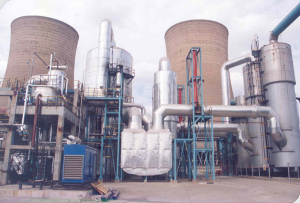 This report comes from local residents and research direct from Zambia where a Foil Vedanta team is currently investigating British based Vedanta’s copper subsidiary KCM and making links with Zambian communities.
This report comes from local residents and research direct from Zambia where a Foil Vedanta team is currently investigating British based Vedanta’s copper subsidiary KCM and making links with Zambian communities.
In the early morning of Friday 13th December high levels of Sulphur Dioxide were released from Vedanta subsidiary KCM’s Nchanga copper smelter in Chingola, Zambia. KCM’s Public Relations manager Joy Sata (a former journalist for Daily Mail Zambia) warned affected communities to stay in their homes until the pollution passed. See news article below.
Sata was quick to point out to the media that the pollution was caused by a national power outage due to disruption at the Kafue Gorge Power Station run by the government power company ZESCO. However, this does not explain why KCM’s smelter was the only one of many other mining companies affected by the power cut to release toxic emissions into the local community. It is clear that KCMs back up power supply was not effective causing their production to stop and releasing damaging emissions.
One local man commented on an online article on the leak saying:
“This Sulphur Dioxide is released even without a power failure. Vedanta resources has failed us and they MUST go!“
 Vedanta’s KCM uses around 13% of Zambia’s electricity, or 250MW. Like other foreign mining companies in Zambia, Vedanta negotiated incredibly low energy prices in the secret Development Agreements they signed with the Zambian government in 2004. Most other mining companies have submitted to government negotiation and agreed a raise in prices, but Vedanta has refused, insisting that the prices remain the same until their 15 year fixed agreement ends in 2020.
Vedanta’s KCM uses around 13% of Zambia’s electricity, or 250MW. Like other foreign mining companies in Zambia, Vedanta negotiated incredibly low energy prices in the secret Development Agreements they signed with the Zambian government in 2004. Most other mining companies have submitted to government negotiation and agreed a raise in prices, but Vedanta has refused, insisting that the prices remain the same until their 15 year fixed agreement ends in 2020.
Nearby Chingola we met members of Shimulala and Helen communities, which are located just downstream of KCM’s tailings dam 2. The water in their local stream is too polluted to drink, and even the borehole which KCM drilled for them after complaints is also highly polluted. This has left them without any fresh water supply and resident are forced to drink dirty water from a shallow borehole they have dug in some marsh land. (Please see upcoming reports for more detail on this. Previous report here)
Interestingly, our Foil Vedanta team have found that at all levels of community, government and even academia here in Zambia people believe Vedanta is an Indian and not a British company. They have been surprised to discover that a British entity could operate with such a pattern of illegalities and pollution.
Recent reports also revealed that KCM’s pollution of local water sources has become so acute that the Bulangililo Water Treatment Plant, which supplies 60% of water for the highly populated Kitwe district may have to be closed.
This news will be of little surprise to those following Vedanta’s legacy in India, where their subsidiary Sterlite released high volumes of sulfur dioxide from their copper smelter this March, bringing 5000 people into the street in reaction, and leading to temporary plant closure. Sterlite is one of many Vedanta subsidiaries which has followed a pattern of operating and expanding without permits, dumping toxic waste, polluting water and causing workers’ deaths.
There is worse news for Vedanta as their share price has dropped to an all time low of 786 pence, with India’s Business Standard newspaper attributing Vedanta’s woes to people’s protests, court cases and regulatory hurdles. The revelation in Zambia that Vedanta is in fact a British company may bring more discredit to Vedanta’s name.
Article on the SO2 release from Wall Street Journal:
Outage damages Zambia’s largest copper smelter
By Nicholas Bariyo
KAMPALA, Uganda–A power outage in Zambia on Friday damaged the country’s largest copper smelter, creating a major setback for the country’s mineral treatment facilities, officials said Saturday.
Joy Sata, a spokeswoman for Konkola Copper Mines, a unit of London-listed Vedanta Resources PLC (VED.LN), said the power outage affected operations at KCM’s 300,000-metric-ton-a-year Nchanga smelter, triggering the emission of sulfur dioxide into the atmosphere in the mining town of Chingola in the Copperbelt province.
“KCM informed affected communities in Chingola to stay indoors and minimize outdoor activities until the situation returns to normal.” Ms. Sata said.
“Production was affected, and the impact will be known after a thorough assessment has been carried out.”
In addition to treating copper from the Konkola mine, Nchanga also smelts copper from other mining companies operating in Zambia, such as First Quantum Minerals Ltd. (FM.T).
Zambia is Africa’s largest copper producer. Since Vedanta acquired Konkola in 2004, it has invested more than $2 billion in expansion projects and is implementing a deep mine project aimed at extending the lifespan of the Konkola mine by at least 35 years. The power failure was triggered by faults at the Kafue Gorge hydropower station, cutting off power from the capital Lusaka and the copper mining heartlands in northern and northwestern Zambia, said the state power utility, Zambia Electricity Supply Corp., or Zesco.
The mines and energy permanent secretary, Charity Mwansa, said Friday that the power failure left Zesco without at least 1,500 megawatts of power for several hours. Mining companies had to scramble to rescue hundreds of miners who were working underground at the time.
Zambia has endured intermittent nationwide power outages in recent years, blamed mainly on obsolete power infrastructure and lack of proper maintenance. The country’s ageing power plants are struggling to keep pace with rising demand for electricity amid expanding copper mining operations.
Zambia’s copper production is expected to rise to 1.5 million tons in the next couple of years from around 800,000 tons produced last year as more copper projects come on stream.